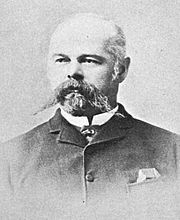| Charles Bendire | |
|---|---|
 Charles Bendire | |
| Birth name | Karl Emil Bender |
| Born | April 27, 1836 |
| Died | February 4, 1897 (aged 60) |
| Place of birth | König im Odenwald, Germany |
| Allegiance | United States |
| Service/branch |
|
| Years of service | 1854 - 1886 |
| Rank | Major |
| Unit |
4th Cavalry 1st Cavalry |
| Wars |
American Civil War Indian Wars |
| Other work | Ornithologist |
Major Charles Emil Bendire (April 27, 1836 – February 4, 1897) was a United States Army soldier and noted ornithologist and oologist. The Bendire's Thrasher is named for him.
Early life[]
Born Karl Emil Bender at König im Odenwald in the Grand Duchy of Hesse-Darmstadt, he was the eldest of six children. Bender was home schooled until the age of twelve, after which he attended five years at a theological school at Passy, near Paris. Karl left school suddenly and returned home, and on the advice of a friend he and his brother Wilhelm Bender left for New York in 1853. Upon arrival they found that the new world did not meet their expectations. Wilhelm Bender soon sailed for home, but was lost overboard at sea.
Army career[]
After his brother's departure, Bender enlisted in the United States Army at the age of eighteen on June 10, 1854, changing his name to Charles Bendire, dropping his middle name altogether. Although Bendire would later start using his middle initial again in correspondence and public notes, his legally official name did not contain a middle name.
Bendire served for five years as a private and subsequently a corporal in Company D, First Dragoons. After his tour of duty ended Bendire left the army for one year, but re-enlisted on June 8, 1860, and was assigned to the 4th Cavalry, where he served successively as a private, corporal, sergeant, and a hospital steward until he was commissioned as a 2nd Lieutenant in the 2nd Infantry on May 18, 1864. He transferred to the 1st Cavalry on September 9, 1864, and was eventually promoted to 1st Lieutenant (for "for gallant and meritorious services" at the battle of Trevilian Station during the American Civil War), and later to captain, and then major. He retired on April 24, 1886, for disability contracted in the line of duty.
During Bendire's service in the army he was sent to many locations, often isolated, across America, for example Virginia, Arizona, Washington and California. Bendire mainly fought against American Indians during the periods of the United States' expansions. It was during these travels across North America that he developed a fondness for all things wild, and particularly birds.
Ornithology[]
He initially sent letters containing his observations to other American naturalists such as Joel A. Allen, Thomas M. Brewer, Elliott Coues, and Robert Ridgway, who would publish them in American naturalist magazines like Bulletin of the Nuttall Ornithological Club and the American Naturalist. However in 1877, he began to publish articles under his own name.
Bendire's private collection of 8,000 eggs formed the basis of the egg collection at the Smithsonian Institution, then known as the U.S. National Museum, in Washington, D.C..[1] He made new discoveries about the migration habits of various birds and discovered several new species, including the Bendire's Thrasher, Toxostoma bendirei.
On 1872 while patrolling in Central Arizona, Bendire reportedly snatched a zone-tailed hawk's egg from a nest for his collection while under fire from an Apache scout and secured it safely in his mouth until he could return to camp.[2]
References[]
- ↑ "Charles E. Bendire (1836-1897)". Smithsonian National Museum of Natural History, Dept. of Vertebrate Zoology, Division of Birds. http://vertebrates.si.edu/birds/Hall_of_fame/CharlesBendire.html. Retrieved 21 June 2013.
- ↑ Patterson, Michael Robert. "Charles Bendire, Major, United States Army". Arlington National Cemetery Website. http://www.arlingtoncemetery.net/charles-bendire.htm. Retrieved 21 June 2013.
External links[]
- Charles Emil Bendire Papers, 1887-1894 from the Smithsonian Institution Archives
- Merrill, J.C. In Memoriam: Charles Emil Bendire. The Auk, Jan. 1898, v. 15, no. 1. p.[1]-6
The original article can be found at Charles Bendire and the edit history here.